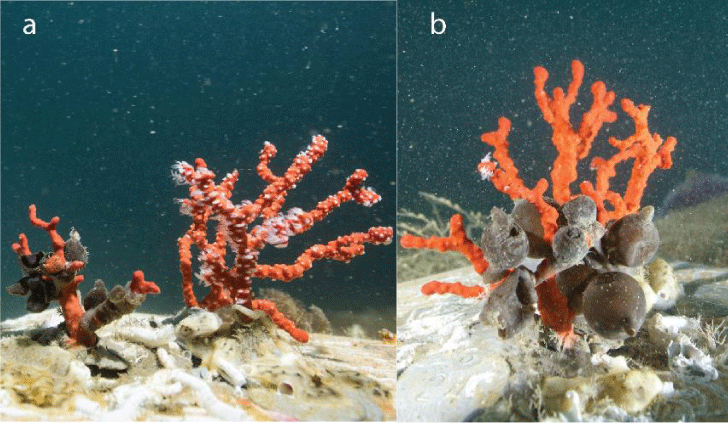Global Journal of Ecology
Mediterranean red coral as a spawning ground for cuttlefish
Federica Maggioni1,2 and Lorenzo Bramanti2*
2CNRS-Sorbonne University, Laboratory of Ecogeochemistry of Benthic Environments, LECOB, Oceanological Observatory of Banyuls sur Mer, 1 avenue Pierre Fabre – 66650, Banyuls sur Mer, France
Cite this as
Maggioni F, Bramanti L (2022) Mediterranean red coral as a spawning ground for cuttlefish. Glob J Ecol 7(2): 120-121. DOI: 10.17352/gje.000071Copyright
© 2022 Maggioni F, et al. This is an open-access article distributed under the terms of the Creative Commons Attribution License, which permits unrestricted use, distribution, and reproduction in any medium, provided the original author and source are credited.The Mediterranean red coral (Corallium rubruma) is a long-lived and slow-growing gorgonian, which suffered intense exploitation due to its precious calcium carbonate skeleton used in jewelry and traded worldwide [1].
Due to its commercial and ecological value, knowledge of the biology of the species has increased noticeably during the last decades as a support to management; however, evidence of its ecological role is scarce [2]. Demographic studies revealed a shift of C. rubrum population structures towards small-sized colonies and raised concern about the risk of the loss of the ecological function of the species [2].
Similarly to other gorgonians, C. rubrum can form dense forests [3] which increase structural complexity and serve as feeding, shelter, and foraging grounds for many associated organisms. Furthermore, coral forests provide favorable conditions for the egg deposition of several species [4].
In the framework of a transplanting experiment near the Marine Protected Area of Cérbere-Banyuls (North Western Mediterranean Sea, France), we observed, at the end of May 2019, one egg mass deposition of the European cuttlefish (Sepia officinalis) on a transplanted healthy C. rubrum colony at 30 m depth (Figure 1). We report some characteristics of the eggs: the diameter of the 9 eggs was comprised between 1.5 and 2 cm, and they presented a swollen and fuller appearance, suggesting that they were at a late stage of embryological development. Moreover, the egg mass contained empty egg capsules indicating that some cuttlefish already hatched (Figure 1) and then suggesting that the C. rubrum colony was a viable structure for their embryological development.
Cephalopods play a key role in marine food webs, and most of them, such as S. officinalis in the Mediterranean and particularly in the area in which the study was performed, are important fishery resources. Cuttlefish egg depositions have been observed on different structures including gorgonians and are not common at depths >25 m [5]. Our observation increased our knowledge of this complex ecological interaction that is difficult to test and demonstrate. In addition, functional linkage among relevant species is a crucial step toward the development of conservation and management strategies. Our observation highlights the importance of Mediterranean red coral habitats as a spawning ground and functional repository for recruits of commercially important species and suggests that small-sized C. rubrum colonies may still fulfill some ecological functions. Those results could help re-evaluate the ecological ecosystem services provided by this precious octocoral, which have been underestimated with respect to the economical ones.
Ethical approval
All applicable international, national, and/or institutional guidelines for the care and use of animals were followed by the authors.
Sampling and field studies
All necessary permits for sampling and observational field studies have been obtained by the authors from the competent authorities.
Data availability
Data sharing is not applicable to this article as no datasets were generated or analyzed during the current study.
- Tsounis G, Grigg R, Gili J. The exploitation and conservation of precious corals. Oceanogr Mar Biol An Annu Rev 48: 161–212.
- Bramanti L, Iannelli M, Santangelo G. Mathematical modeling for conservation and management of gorgonians corals: youngs and olds, could they coexist? Ecol. Modell. 2009; 220: 2851–2856.
- Rossi S, Bramanti L, Gori A, Orejas C. An Overview of the Animal Forests of the World. In book: Marine animal forests. 1-26.
- Cau A, Follesa MC, Moccia D, Bellodi A, Mulas A, Bo M, Canese S, Angiolillo M, Cannas R. Leiopathes glaberrima millennial forest from SW Sardinia as a nursery ground for the small-spotted catshark Scyliorhinus canicula. Aquatic conservation-Marine freshwater ecosystems. 2017; 27:731–735.
- Guerra A, Hernandez-Urcera J, Garci ME, Sestelo M, Regueira M, Gilcoto M, Gonzalez AF. Spawning habitat selection by the common cuttlefish Sepia officinalis in the Cíes Islands (Northwest Spain). Fishery Research. 2016; 183: 44-54.
Article Alerts
Subscribe to our articles alerts and stay tuned.
 This work is licensed under a Creative Commons Attribution 4.0 International License.
This work is licensed under a Creative Commons Attribution 4.0 International License.



 Save to Mendeley
Save to Mendeley
